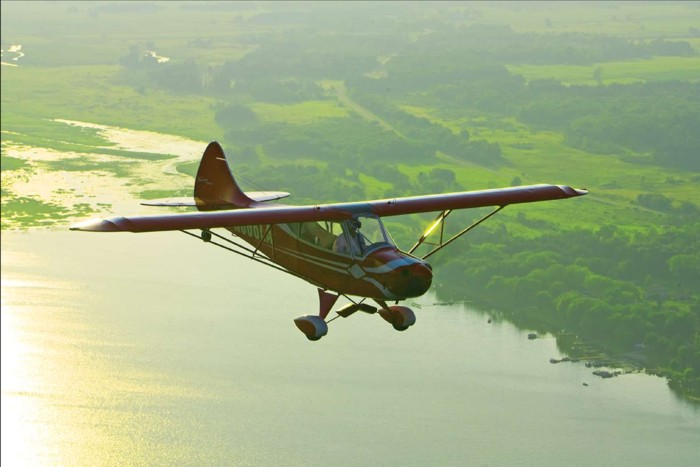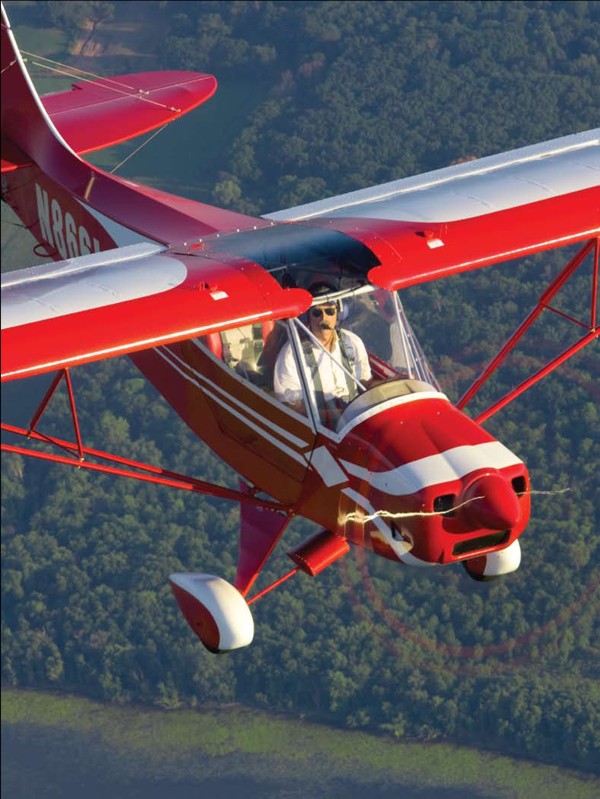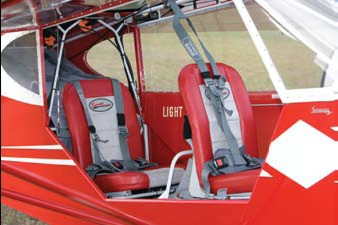





Want flaps? The Savage has ’em, unlike original
J-3 Cubs. Savage demo pilot John Mohr
appreciates the addition of the flaps in slowing
the aircraft down.

Keith and Julie Hartlaub of Savage Aircraft Sales
are now the distributors of this Zlin design in the
United States. Keith recently earned a light-sport
repairman maintenance rating to provide maintenance
assistance to their customers. [UPDATE 6/23/10 — SportAirUSA has now taken over U.S. distribution; the Hartlaubs will stay on as regional dealers.

With a generous skylight overhead, visibility from
the Savage is expansive. Because the airplane can
be flown solo from the front seat, S-turns aren’t
needed to maneuver this taildragger on the ground.

The low-slung door on the right side makes getting
in and out of the airplane easy. A door on the
left side is an option ($2,000 extra) and something
float-plane fliers would likely find quite desirable.

As stated before, the Savage can be flown
solo from the front seat so that’s where the main
instrument panel is located. However, there’s
a small instrument pod in the back seat with a
turn-and-bank indicator, air speed indicator, and
altimeter inset.
As we near the fourth anniversary of the introduction
of the first special light-sport aircraft
(S-LSA) in April 2004, notable successes have
been achieved. With approximately 1,000 fixed-wing
LSA-plus several hundred flex wings-in the national
fleet, and with the entry of Cessna and Cirrus into the
LSA marketplace, LSA have clearly become part of the
aviation scene.
Whatever the soothsayers predict for the future
of LSA, one fact has been established: Pretty yellow
taildraggers generate a solid following. Combining
the sales of American Legend Aircraft’s Legend Cub,
CubCrafters’ Sport Cub, and European supplier Zlin’s
Savage, nearly one in five S-LSA registered in the FAA’s
database are yellow taildraggers.
American Legend currently leads in market share, but
CubCrafters steadily rose through the ranks during 2007.
Well down the list, but with mounting registrations, is the
Zlin Savage. Though it more closely resembles the RANS S-7
Courier than the traditional J-3 Cub, the Zlin taildragger has
much to offer.
Savor the Differences
Two salient features separate the
Savage from the Legend Cub or Sport
Cub. First is the price. At the 2008
retail price of $70,000, the Europeanbuilt
Savage costs so much less than
the two American-made products
that you might wonder if something
major is missing. Second, the Savage
comes in with an empty weight of
673 pounds before loading it up with
accessories. That’s a hundred pounds
less than the other two. As with most
light aircraft I’ve flown, this quality
alone suggests the Savage will perform
admirably. Of course, the Rotax
912 powerplant contributes to both
of these factors.
I flew a red Savage with John
Mohr, proprietor of John Mohr
Barnstorming. Flying a Stearman in
air shows, he has logged an incredible
37,000 hours. But he’s more than
a highly skilled pilot; John built his
first aircraft at the age of 17. That
early project was a helicopter, and he
obviously liked the experience. He’s
since built a total of four helicopters.
John’s family bought a new J-3
Cub in 1947 and has owned it ever
since. It has trained four generations
of pilots, so it has great sentimental
value to the Mohr family. Beyond
that appeal, however, John says he
prefers flying the Savage, saying it
has more performance and better
handling, plus he enjoys having
flaps, with which the 1947 Cub isn’t
equipped. The Savage’s flaps can be
set to three deployed settings up to
35 degrees.
The tailplane of the Czechdesigned,
Italian-assembled Savage
is fabric-covered, as are the fuselage
and wings, though the ailerons and
flaps are aluminum. The Savage has
a door on only the right side, like
all original Cubs. This is probably
one way to save a few dollars, but it
limits the wide-open flying that can
be achieved with two doors open. A
single door also limits your options
for exiting the aircraft when flying
on floats and trying to secure the
airplane to a pier or dock. A left-side
door is available on the Savage at a
cost of about $2,000, well worth the
price if you want the versatility of
getting out on either side when docking
at a pier.
Tandem Cabin
The recommended way to enter the
Savage is either to back in and sit
down first or swing a leg in. I chose
the latter as a means to enter without
having to pull my leg inside and
then over the joystick, which seemed
awkward. Fortunately, the welded
steel interior offered a number of safe
handgrips to use in achieving the
somewhat trickier leg-first entry.
The Savage’s only door opens and
latches with a central latch, although
a secondary latch is located forward,
which helps secure the door at the
leading edge, but it would be difficult
or impossible to reach from the
aft seat.
The Savage is flown solo from the
front seat, dictated less by weight and
balance and more by flap operation,
which can only be done from the
front seat. Most pilots probably prefer
the front seat anyway, but flying
from the rear seat is highly functional,
and I performed well from this
location. I had chosen to sit here to
experience the Zlin model from a different
perspective. Were the Savage
my own, I’d want at least a tachometer and an airspeed indicator in the
aft seat to make the airplane more
flyable from either seat.
Mohr and I flew the Savage from
the ultralight/lightplane runway at EAA
AirVenture Oshkosh 2007. The field
proved no great challenge for the Savage,
at least in John’s capable hands.
When we taxied out for launch
I observed that the toe brakes were
very effective. Because the tail wheel
is fully castoring, you can maneuver
the Savage compactly. John showed
me a handy technique of easing the
stick forward to unload the tail wheel
a bit (while running some power),
allowing it to break loose more readily
for extremely tight maneuverability.
You can pivot the plane around
a single main gear with a bit of practice.
After his demonstration of the
Savage’s handling qualities, I was able
to emulate John’s techniques thanks
to full dual controls in the Savage.
Hydraulic toe brakes are also offered
at both seats.
Fortunately, the great forward visibility
of the Savage means you don’t
need much ground maneuverability.
Unlike most taildraggers, S-turns are
rarely needed in the Savage.
Once aloft, John wanted to demonstrate
the in-flight door-opening
procedure. As we slowed the airplane
to about 60 knots, John prepared
to open the door. He released the
front latch first and then the main,
centrally located latch and let the
door swing upward. My recorded
notes captured a blast of wind in the
cockpit and especially in my rear seat.
But the ultralight pilot in me immediately
loved the feeling.
Wisconsin Barnstorming
John’s an airshow performer and I’m
a longtime ultralight pilot-seemingly
distant ends of the aviation spectrum-
but we both enjoyed flying
low over the Wisconsin pastures. We
enjoyed drifting along over the wideopen
fields, flying at 55 knots and
using no flaps.
As with all the Cub replicas or
re-creations, slow flying is their
strength. The same is true of the
Savage. But not all Savage models
are alike. Vortex generators were
added to one Savage on display at
AirVenture 2007. Can they actually
help a simple airfoil such as these
aircraft use?
The answer is yes. John indicated
that, of the two Savages at AirVenture
2007, the one fitted with vortex generators
could fly significantly slower
than the other. John said it will slow
so much that you can practically
land it on the tail wheel. We flew
the Savage without vortex generators,
and John prefers to wheel-land this
model. Readers interested in shortfield
operations or float operations
would surely want such efficient vortex
generators.
Following John’s lead, I found
landings could make good use of a bit
of power; the Savage then flies down
to the ground with wonderful behavior.
It was hard to take note of speeds
from the aft seat, but my seat-ofthe-
pants technique, combined with
good airplane behavior, contributed
to easy landings. Flying the Savage,
like nearly all taildraggers, requires
“happy feet.” Active foot movements
keep the rudder pedals in motion
with lots of small corrections, after
which taildraggers can seem simple
to fly.
Despite proper technique, I had
one landing where I dropped the
Savage in a bit. John thinks I got
a little slow and at some point, he
said, the Savage without the vortex
generators experiences a flow separation
and this allows the plane to drop
to the ground. Flying with a touch
of power cures this as does the VG
setup. I’d choose the latter for this
reason alone.
The Savage does excellent forward
or sideslips in either direction, no
doubt thanks to its generous side
area, all the while demonstrating
great control authority.
Falling Leaf
I have long used Dutch rolls to discover
handling qualities of a new
airplane. Adding to this practice,
John taught me the “falling leaf”
maneuver. This is a similar but somewhat
extreme form of the Dutch roll
where you start to enter a spin but,
before allowing the airplane to actually
spin, you arrest it and reverse
the direction. The Savage certainly
revealed the falling leaf, in fact wafting
around noticeably during the
maneuver. John reports his Stearman
does this maneuver more gracefully,
but repeating the falling leaf maneuver
allows you to more quickly recognize
an incipient spin and to practice
recovery. I would not recommend
it to less experienced pilots, but in
the hands of an expert like John, it
appears a highly useful exercise.
I noticed in steep turns, especially
to the left, that I tended to run out
of back-stick unless I added a touch
more power. This is a common occurrence
in most general aviation airplanes
I’ve flown, but not always in
the lighter-weight metal or composite
LSA. To the right, this result was
less apparent.
I flew the whole flight from the
rear seat and did very well from
this position. I also discovered that
a rear-seat pilot can make great use
of the overhead skylight in turns,
probably more so than someone
seated up front and closer to the
skylight.
Cruising around the fields neighboring
AirVenture at 5000 rpm,
Savage showed us about 85 knots
indicated. It can cruise a bit faster,
but I found the power setting to
deliver solid power with a bit less
noise and vibration.
The yellow, vortex generatorequipped
Savage is also lighter than
the red Savage we flew because it has
fewer accessories. John reported flying
it at 4700 rpm where he observed
an indicated 100 mph or 86 knots.
The speeds appear similar for both
versions, but you need 300 fewer
revolutions out of the 100-hp Rotax
912S engine to achieve the same
low-range cruise in the vortex generator-
equipped variation. For those
not familiar with Rotax engines, it’s
important to know that 4700 is a
lower power setting, perhaps equivalent
to 2300 rpm on a Continental
or Lycoming engine.
When I ran my stall regimen
in the no-vortex generator Savage
using flaps, the power-off stall came
gently without a break at 38 knots
indicated. Using full flaps, the airspeed
indicator dropped below 30
knots with a mild stall break. John
indicated that the VG-equipped
model could fly all day at an indicated
20 knots and that it was possible
to drop the airspeed indicator
(ASI) to zero. Of course, at these
nose-high attitudes, any ASI has
considerable error.
John demonstrated a hammerhead
stall, pulling up to nearly vertical
and then pivoting over on one
wing. The pullout from this aerobatic
maneuver hardly exceeded 80
knots with a slight g-load in pullout.
The slower speed of the Savage illustrates
one of the benefits of flying
a slower, high-lift wing: You are far
less likely to overstress the structure
in high-speed maneuvers.
Taming the Savage
Keith and Julie Hartlaub replaced
Bob West of North American Sport
Aviation as the distributor of the
Savage, operating under the business
name Savage Aircraft Sales based at
the Manitowoc County (Wisconsin)
Airport (KMTW). Though West
deserves some credit for introducing
the Savage to Americans, the
Hartlaubs have increased the airplane’s
exposure. The Hartlaubs
are also part owners of Lakeshore
Aviation. With their combined enterprises,
they can offer flight training,
insurance checkouts, delivery services,
and maintenance. Lakeshore
is also an authorized Rotax engine
repair center.
Given the euro’s strong rise against
the dollar in recent years, I’m amazed
that Savage Aircraft Sales can sell a
euro-denominated import for tens of
thousands less than other LSA after
shipping the airplane to the U.S. The
price did rise 17 percent from $60,000
in the last year, yet it remains in the
lower range of ready-to-fly LSA you
can purchase.
The Savage Classic at the 2008
price of $70,000 includes the following
equipment: a 100-hp Rotax 912S
engine with a two-blade, wooden propeller,
single-color paint scheme, airspeed
indicator, altimeter, compass,
slip indicator, engine tachometer,
hour meter, cylinder head temperature
gauge, oil temperature gauge, oil pressure
gauge, dual controls, four-point
seat belt system, overhead skylight,
storage compartment, standard upholstery,
600-by-6 wheels and tires, and
hydraulic toe brakes. Savage Aircraft
Sales also offers a list of options.
With a $70,000 base price, the
Zlin design competes superbly with
the American Legend Cub or the
CubCrafters Sport Cub, which retail
for tens of thousands more. RANS’ S-7
Courier is more price-competitive at
about $75,000 ready to fly. Given the
euro’s current strong run against the
dollar, the $70,000 U.S. selling price
is truly a remarkable achievement.
Should the dollar strengthen, Zlin may
sell all the airplanes it can produce.
With great flight qualities and solid
new U.S. representation, the Savage’s
price alone suggests you ought to
closely examine the Zlin Savage if
you’re an LSA enthusiast who likes
pretty yellow taildraggers-or even
red ones, for that matter.
| Seating | 2, tandem |
| Empty weight | 673 pounds |
| Gross weight | 1m235 pounds |
| Wingspan | 30.5 feet |
| Wing area | 153.0 square feet |
| Wing loading | 8.1 pounds/square foot |
| Length | 21 Feet |
| Cabin Interior | 30 inches |
| Height | 6.7 feet |
| Fuel Capacity | 18 gallons |
| Baggage area | Aft of seats, max 43 pounds |
| Airworthiness | Certified SLSA |
| Standard engine | Rotax 912 UL2/ULS2 |
| Prop Diameter | Two-blade, wood |
| Power | 80-100 hp |
| Power loading | 13.2 pounds/horsepower |


Leave a Reply